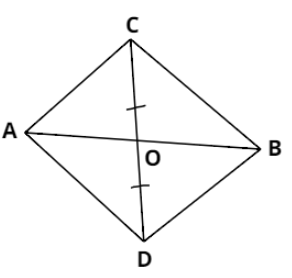
Answer
498.3k+ views
Hint: Since line AB is bisecting line CD, O is the midpoint of CD. Therefore AO and OB are the medians of triangles ACD and BCD. Use the property that a median divides a triangle into two parts of equal areas.
Complete step-by-step answer:
According to the question, line segment CD is bisected by AB at point O. So, we have:
$ \Rightarrow OC = OD$
In $\Delta ACD$, we have $OC = OD$. Therefore AO is the median of $\Delta ACD$.
We know that a median divides a triangle into two triangles of equal areas. So we have:
$\therefore {\text{ar}}\left( {\Delta AOC} \right) = {\text{ar}}\left( {\Delta AOD} \right) .....(i)$
Similarly in $\Delta BCD$, $BO$ is the median because CD is bisected by AB at O. So, we have:
$\therefore {\text{ar}}\left( {\Delta BOC} \right) = {\text{ar}}\left( {\Delta BOD} \right) .....(i)$
Adding equation $(i)$ and $(ii)$, we’ll get:
$ \Rightarrow {\text{ar}}\left( {\Delta AOC} \right) + {\text{ar}}\left( {\Delta BOC} \right) = {\text{ar}}\left( {\Delta AOD} \right) + {\text{ar}}\left( {\Delta BOD} \right) .....(iii)$
And from the figure we can say that \[{\text{ar}}\left( {\Delta AOC} \right) + {\text{ar}}\left( {\Delta BOC} \right) = ar\left( {\Delta ABC} \right)\] and \[{\text{ar}}\left( {\Delta AOD} \right) + {\text{ar}}\left( {\Delta BOD} \right) = ar\left( {\Delta ABD} \right)\]. So putting these values in equation $(iii)$, we’ll get:
$ \Rightarrow ar\left( {\Delta ABC} \right) = ar\left( {\Delta ABD} \right)$.
This is the required proof.
Note: A median of a triangle is a line drawn from a vertex of the triangle to the third side dividing it into two equal parts. Thus, a triangle can have three different medians. Medians also divide the triangle into two parts of equal area.
Complete step-by-step answer:
According to the question, line segment CD is bisected by AB at point O. So, we have:
$ \Rightarrow OC = OD$
In $\Delta ACD$, we have $OC = OD$. Therefore AO is the median of $\Delta ACD$.
We know that a median divides a triangle into two triangles of equal areas. So we have:
$\therefore {\text{ar}}\left( {\Delta AOC} \right) = {\text{ar}}\left( {\Delta AOD} \right) .....(i)$
Similarly in $\Delta BCD$, $BO$ is the median because CD is bisected by AB at O. So, we have:
$\therefore {\text{ar}}\left( {\Delta BOC} \right) = {\text{ar}}\left( {\Delta BOD} \right) .....(i)$
Adding equation $(i)$ and $(ii)$, we’ll get:
$ \Rightarrow {\text{ar}}\left( {\Delta AOC} \right) + {\text{ar}}\left( {\Delta BOC} \right) = {\text{ar}}\left( {\Delta AOD} \right) + {\text{ar}}\left( {\Delta BOD} \right) .....(iii)$
And from the figure we can say that \[{\text{ar}}\left( {\Delta AOC} \right) + {\text{ar}}\left( {\Delta BOC} \right) = ar\left( {\Delta ABC} \right)\] and \[{\text{ar}}\left( {\Delta AOD} \right) + {\text{ar}}\left( {\Delta BOD} \right) = ar\left( {\Delta ABD} \right)\]. So putting these values in equation $(iii)$, we’ll get:
$ \Rightarrow ar\left( {\Delta ABC} \right) = ar\left( {\Delta ABD} \right)$.
This is the required proof.
Note: A median of a triangle is a line drawn from a vertex of the triangle to the third side dividing it into two equal parts. Thus, a triangle can have three different medians. Medians also divide the triangle into two parts of equal area.
Recently Updated Pages
Fill in the blanks with suitable prepositions Break class 10 english CBSE

Fill in the blanks with suitable articles Tribune is class 10 english CBSE

Rearrange the following words and phrases to form a class 10 english CBSE

Select the opposite of the given word Permit aGive class 10 english CBSE

Fill in the blank with the most appropriate option class 10 english CBSE

Some places have oneline notices Which option is a class 10 english CBSE

Trending doubts
Fill the blanks with the suitable prepositions 1 The class 9 english CBSE

How do you graph the function fx 4x class 9 maths CBSE

When was Karauli Praja Mandal established 11934 21936 class 10 social science CBSE

Which are the Top 10 Largest Countries of the World?

What is the definite integral of zero a constant b class 12 maths CBSE

Why is steel more elastic than rubber class 11 physics CBSE

Distinguish between the following Ferrous and nonferrous class 9 social science CBSE

The Equation xxx + 2 is Satisfied when x is Equal to Class 10 Maths

Differentiate between homogeneous and heterogeneous class 12 chemistry CBSE





